Mapping of functional regions in the amino-terminal portion of the herpes simplex virus ICP27 regulatory protein: importance of the leucine-rich nuclear export signal and RGG Box RNA-binding domain
- PMID: 12414929
- PMCID: PMC136872
- DOI: 10.1128/jvi.76.23.11866-11879.2002
Mapping of functional regions in the amino-terminal portion of the herpes simplex virus ICP27 regulatory protein: importance of the leucine-rich nuclear export signal and RGG Box RNA-binding domain
Abstract
Infected-cell protein 27 (ICP27) is an essential herpes simplex virus type 1 (HSV-1) regulatory protein that activates a subset of viral delayed-early and late genes, at least in part through posttranscriptional mechanisms. Previous studies have shown that the amino (N)-terminal half of the protein contains important functional regions, including a leucine-rich nuclear export signal (NES). However, to date, the phenotype of an HSV-1 ICP27 NES mutant has not been reported. In this study, we engineered and characterized dLeu, an HSV-1 deletion mutant that specifically lacks ICP27's NES (amino acids 6 to 19). The phenotype of dLeu was analyzed alongside those of eight other ICP27 N-terminal deletion mutants. We found that in Vero cells, dLeu displays modest defects in viral gene expression and an approximately 100-fold reduction in the production of viral progeny. Unlike wild-type (WT) ICP27, which exhibits a cytoplasmic distribution in addition to its predominant nuclear localization, dLeu ICP27 is highly restricted to the cell nucleus. This strongly suggests that the N-terminal leucine-rich sequence functions as an NES during viral infection. Our analysis of dLeu and the other mutants has enabled us to genetically define the regions in the N-terminal 200 residues of ICP27 which are required for efficient viral growth in Vero cells. Only two regions appear to be important: (i) the leucine-rich NES and (ii) the RGG box RNA-binding domain, encoded by residues 139 to 153. A virus lacking the RGG box-encoding sequence, d4-5, has a phenotype similar to that of dLeu in that it displays modest defects in viral gene expression and grows poorly. Interestingly, deletion of both the NES and RGG box, as well as the sequences in between, is lethal. The resulting virus, d1-5, displays severe defects in viral gene expression and DNA synthesis and is unable to produce significant amounts of infectious progeny. Therefore, the N-terminal portion of ICP27 contains at least two functional domains which collectively are absolutely essential for viral infection.
Figures

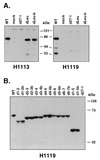
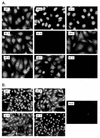


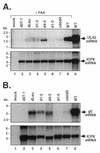
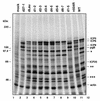
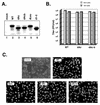
Similar articles
-
Identification of an export control sequence and a requirement for the KH domains in ICP27 from herpes simplex virus type 1.J Virol. 2000 Aug;74(16):7600-9. doi: 10.1128/jvi.74.16.7600-7609.2000. J Virol. 2000. PMID: 10906214 Free PMC article.
-
Arginine-rich regions succeeding the nuclear localization region of the herpes simplex virus type 1 regulatory protein ICP27 are required for efficient nuclear localization and late gene expression.J Virol. 1995 Aug;69(8):4656-67. doi: 10.1128/JVI.69.8.4656-4667.1995. J Virol. 1995. PMID: 7609030 Free PMC article.
-
Three arginine residues within the RGG box are crucial for ICP27 binding to herpes simplex virus 1 GC-rich sequences and for efficient viral RNA export.J Virol. 2010 Jul;84(13):6367-76. doi: 10.1128/JVI.00509-10. Epub 2010 Apr 21. J Virol. 2010. PMID: 20410270 Free PMC article.
-
The many roles of the regulatory protein ICP27 during herpes simplex virus infection.Front Biosci. 2008 May 1;13:5241-56. doi: 10.2741/3078. Front Biosci. 2008. PMID: 18508584 Review.
-
The role of viral and cellular nuclear proteins in herpes simplex virus replication.Adv Virus Res. 1989;37:85-123. doi: 10.1016/s0065-3527(08)60833-7. Adv Virus Res. 1989. PMID: 2557760 Review.
Cited by
-
Control of VP16 translation by the herpes simplex virus type 1 immediate-early protein ICP27.J Virol. 2005 Apr;79(7):4120-31. doi: 10.1128/JVI.79.7.4120-4131.2005. J Virol. 2005. PMID: 15767413 Free PMC article.
-
Herpes simplex virus 1 regulatory protein ICP27 undergoes a head-to-tail intramolecular interaction.J Virol. 2010 May;84(9):4124-35. doi: 10.1128/JVI.02319-09. Epub 2010 Feb 17. J Virol. 2010. PMID: 20164236 Free PMC article.
-
Herpes simplex virus ICP27 activation of stress kinases JNK and p38.J Virol. 2005 Jul;79(13):8348-60. doi: 10.1128/JVI.79.13.8348-8360.2005. J Virol. 2005. PMID: 15956580 Free PMC article.
-
Viral regulation of mRNA export.J Virol. 2004 May;78(9):4389-96. doi: 10.1128/jvi.78.9.4389-4396.2004. J Virol. 2004. PMID: 15078920 Free PMC article. No abstract available.
-
Enhancement of HSV-1 cell-free virion release by the envelope protein gC.Virology. 2024 Aug;596:110120. doi: 10.1016/j.virol.2024.110120. Epub 2024 May 23. Virology. 2024. PMID: 38805801 Free PMC article.
References
-
- Blaho, J. A., C. Mitchell, and B. Roizman. 1994. An amino acid sequence shared by the herpes simplex virus 1 alpha regulatory proteins 0, 4, 22, and 27 predicts the nucleotidylylation of the UL21, UL31, UL47, and UL49 gene products. J. Biol. Chem. 269:17401-17410. - PubMed
Publication types
MeSH terms
Substances
Grants and funding
LinkOut - more resources
Full Text Sources
Other Literature Sources

